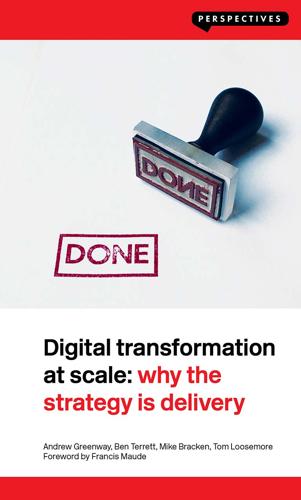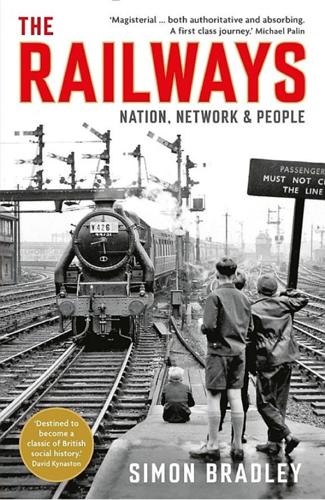
Digital Transformation at Scale: Why the Strategy Is Delivery
by
Andrew Greenway,Ben Terrett,Mike Bracken,Tom Loosemore
Published 18 Jun 2018
Given the chance, statisticians will say data scientists are just chancers with good PR blagging the same job they’ve been unfashionably plugging away with for years. That’s an argument for another book. Many of the skills needed for digital transformation are not new. The UK government has achieved some proud moments in design, for example (Henry Beck’s famous Underground map and Margaret Calvert and Jock Kinneir’s work on road signs in the 1960s37 were both emulated worldwide), and couldn’t have done that without employing people who understood its value. Most countries have only recently learned how to be consistently terrible at IT; governments and public institutions laid most of the foundations for modern computing and the web.
…
Find the right people; don’t expect them to find you. Look to trusted networks and expert communities. * * * 36 http://mikebracken.com/blog/on-policy-and-delivery/; Institute for Government, October 2014. 37 http://www.britishroadsignproject.co.uk/jock-kinneir-margaret-calvert/ 38 Leisa Reichelt, http://www.disambiguity.com/alphagov/ 39 http://www.literacytrust.org.uk/adult_literacy/illiterate_adults_in_england 40 http://contentdesign.london/home/book/ 41 https://gds.blog.GOV.UK/2015/07/10/you-cant-be-half-agile/ 42 Or any other stationery shop.

British Rail
by
Christian Wolmar
Published 9 Jun 2022
The success and durability of the double arrow logo are demonstrated by the fact that it survived rail privatization and is used today on Google maps to show the location of railway stations. The new font was another success. Rail Alphabet, a sans serif typeface based on the Swiss Helvetica lettering, was created by Jock Kinneir and Margaret Calvert. The two designers were also responsible for the font used on the much clearer road signage that was being introduced around the same time, as well as the now-famous NHS lozenge logo. The design was quickly adopted on new, bigger signs at stations, which replaced the old BR ‘totem’ ones, a pleasant but somewhat fussy cylindrical design with sans serif lettering that had been introduced on the creation of BR in 1948 and had been used for all stations in different colours according to the region.
…
ABB 236, 317 Aberdare-Abercynon line 325 Aberdeen 237 accidents 33–4, 291–2, 294–5, 296–7 after privatization 339, 340 Clapham Junction rail crash 291, 292–6 and Mark 1 carriages 45–6 see also safety Advanced Passenger Train (APT) 165–78, 303, 304, 328 advertising see marketing air brakes 67 Allen, Geoffrey Freeman 126, 161 Alsthom 236, 317 Anglo-Scottish Car Carrier Service 38–40 Anne, Princess 289 Advisory, Conciliation and Arbitration Service (ACAS) 217 Ascot 47 Ashford-Hastings route 137–8 ASLEF (Amalgamated Society of Locomotive Engineers and Firemen) 197–8, 214 and APT 169 driver only operation 222 flexible rostering 218, 219–20 and NUR 218–19 OfQ 311 strikes 218–21 Atlantic Coast Express 52 Austin, Chris Beeching report 86, 88–9, 98 on bias towards affluent rail passengers 145 on closures 156 graduate training scheme 240–41 Settle–Carlisle line 264 singling 137–8 Stedeford report 79–80 Australia 185 Automobile Association (AA) 131–2 aviation xiii, 14, 18, 106, 175, 185, 299 Avocet line 134 Azuma 186 Bagwell, Philip 200, 203–4, 205, 206, 207–8, 209 Baldwin, Peter 148 Balfour Beatty 8 Barney, Gerry 109 barons 64–5, 126, 161, 250, 251, 254, 260, 268 Beatles 100 BedPan line 216, 221 Beeching, Dr Richard xi, 9, 62, 82–4, 92, 94, 105–6, 128 appointment 73, 75–6, 82, 84–5 corporate identity 107, 109 departure 99–100 The Development of the Major Railway Trunk Routes (second report) 95–8, 99, 101, 133, 240 electrification 94–5 industrial relations 199–200 Reshaping of British Railways (first report) 84, 85–95, 100, 101, 162 on Stedeford committee 79, 81–2 Betjeman, John 11, 116 BICC (British Insulated Callender’s Cables) 8 bicycles 48–9, 114 Birmingham New Street station 10 bishops 25 black boxes 296 Bleasdale, Cyril 298–9, 305 Bletchley flyover 66 Blue Paper 143–4, 156 Blue Pullmans 159–62, 180 Bonavia, Michael British Transport Commission meetings 57–8 and electrification 7–8, 9 liveries 32 steam locomotive policy 30–31 and Stedeford committee 80 Boyd, Adrian 289 Bradley, Simon 44, 47–8, 127 braking systems 168, 180 Branchline Commission 69–71 BREL (British Railways Engineering Ltd) 190, 234, 235, 239 HSTs 183 Networker 316–17 Pacers 271 British Rail 101, 111, 353 see also British Railways British Rail Property Board 237 British Railways (BR) xv, xvii, 353 beginning the break-up 225–39 Blue Paper 143–4, 156 Chief Mechanical and Electrical Engineering Department 167, 177, 234 common carrier obligation 24, 65 corporate identity 31–3, 106–115, 127 Field organization 257, 258 functional departments 254–5 funding xiii, 128, 135–6, 139, 190, 191, 264–5, 266–7, 321, 328–9, 332 headquarters 21, 255 Modernisation Plan 5, 6, 9, 17, 59–73, 75, 84–5, 100, 108, 120, 128, 233, 234 myths ix–x name change 111 nationalization 17–26, 53–4 organizing for quality 309–310, 311–15, 326 pre-privatization golden age 326–9 privatization x–xiv, xv, xvii, 309, 323–4, 329, 331–42 Pullmans 35–6 regions 25, 27–8, 64–5, 126, 251–5, 257, 260 sectorization 241, 258–60, 266–73, 279, 307–8, 309 Serpell report 150, 151–5, 193, 248 Shipping and International Division 229 Stedeford committee 79–81 see also InterCity; Network SouthEast; Provincial Railways; ScotRail British Railways Board 79, 82, 353 APT 177–8 Design Panel 107 electrification 7 HST 177–8 InterCity 162 and orange paper 147 sectorization 259 A Strategy for High Speed 177–8 workshop privatization 236 British Railways Engineering Ltd see BREL British Railways Research and Development Division 166 British Transport Commission (BTC) 19–21, 56, 57 abolition 79, 83 closures 71–2 Design Panel 107 electrification 6, 7 insignia 32 Modernisation Plan 67–9 and Pullman 36 steam locomotive policy 27, 29 British Transport Hotels (BTH) 227–8, 230 Broad Street line 141 Broxbourne station 118 Brunel, Isambard Kingdom 169, 181, 251 Buckton, Ray 218–19 bus services 190–91, 226 bustitution 96, 146, 149 Butler, R. A. 62 Cab Secure Radio 296 Callaghan, Jim 149–50 Calvert, Margaret 110 Campbell, Ian 171 camping coaches 50–51 Cannon Street station rail crash 297 Capitalcard 281–2, 283 Captials Limited 35 car ownership 56, 78, 131–2, 187, 299, 322–3 Carlisle 67 Casey Jones 231 Castle, Barbara 128, 129–34, 135, 136, 156, 195–6, 271 catering cafeterias and tea trolleys 37 HST 180 InterCity 300, 301 privatization 231–3 sandwiches ix, x, xvii Causebrook, Mark 268 Centre for Policy Studies 246 Channel Tunnel 332 Channon, Paul 236, 263, 333 Charing Cross station 237 Chiltern line 316 City Link 192–3 Clapham Junction rail crash 291, 292–6 CLASP (Consortium of Local Authorities Special Programme) 116–17 Clean Air Act 1956 33 clock-face timetabling 163 closures 1970s 139–42 1980s 324–6 Beeching 81–2, 83, 85–94, 95–101, 105–6, 138 Blue Paper 143–4, 156 by stealth 72, 325–6 Castle 132, 133–4 cost-benefit analysis 156–7 in privatization legislation 264 reopenings 324–5 Serpell report 152–3, 155, 260 Settle–Carlisle line 261–4 Stedeford committee 80–81 1960 White Paper 81 1974 White Paper 148 1977 White Paper 148, 149 coach services 190–91, 277, 299 coal wagons 92–3 Cockerell, Christopher 77 commercial railway 24, 135, 152, 258 common carrier obligation 24, 65 computerization 203–4 Concorde 175 Conran, Terence 109 consultants 239–40 container traffic 86, 92, 93, 131 continuous welded rail 201, 253, 281 Coopers & Lybrand 247 Cornwall Skippers 271, 319 cost-benefit analysis 61, 156–7 Cotton, Ron 262 Coventry station 10, 118 Covid-19 pandemic xv, 342 Crosland, Tony 144–6, 148 Cross Country 185, 186, 298 Cuisine 2000 232, 233 Cyclists Special (British Transport Film) 49 Daily Mail 172 Dalgleish, Angus 244 Dartmoor 72 Davies, Hunter 94, 95, 96 Day, Robin 109 Deltic diesel locomotives 5, 15, 84–5, 95, 185, 301 Deming, Edwards 313 Denning, Lord 78 Department of the Environment 353 closures 140 rail to road conversion 245 see also Ministry of Transport Department of Transport 353 Capitalcard 281 Great British Railways xvii rail privatization 331, 334, 335 see also Ministry of Transport Derbyshire, Nick 238 Design Panel 107, 111 Design Research Unit 107 The Development of the Major Railway Trunk Routes (second Beeching report) 95–8, 99, 101, 133, 240 diesel locomotives 5, 13, 84, 120–21, 125, 252 and APT 170 Deltics 5, 15, 84–5, 95, 185, 301 diesel-electrics 64, 125 diesel-hydraulics 64, 125–6 HST 162, 165, 176–86 and loading gauge 27 Modernisation Plan 63, 64–5, 72–3, 233 staffing 5–6, 123–4, 206–7 diesel multiple units 28–9, 121, 159, 269 Blue Pullmans 159–62 Pacers 269–71, 318–19 Sprinters 272–3, 319, 323 disabled travellers 43, 114 Disconnected!

The Railways: Nation, Network and People
by
Simon Bradley
Published 23 Sep 2015
The Design Research Unit was not the only outside body helping to transform old British Railways into new British Rail. A system of universal signage was also introduced, finally doing away with regional colour-coding. The signs were lettered in the Rail Alphabet, a sans serif typeface designed by Richard ‘Jock’ Kinneir and Margaret Calvert. After a spell at the DRU, Kinneir had set up his own design practice in 1956. One early commission was the signage for the new Gatwick Airport. Soon after, he was appointed chief designer to the Advisory Committee on Traffic Signs on Motorways, with Calvert as his assistant. Breaking with tradition, Kinneir recommended mixed-case rather than wholly upper-case lettering, arguing that this was at once easier for the motorist to read and more in tune with the spirit of post-war Britain, which had ‘moved on from the Victorian concept of empire’.
…
S. 215–17, 519 bullet trains 206, 238, 267 bullhead rails 259, 259 Bulwer-Lytton, Edward 98, 125 Burdett-Coutts, Angela, Baroness 87 Burge, J. Thornton 460–1 Burns, W. C. 95 Burton-on-Trent 344–5, 529 Busby, Matt 226 buskers 68 butter 346 C CAF 250 Caledonian Railway 30, 203–4, 479 Caledonian Sleeper 249–50 Callaghan, James 217 Calvert, Margaret 504 Cambrian Coast route 305 Cambrian Railways 357, 366–7, 459 Cambridge 95–6, 100–1, 220, 413, 448, 507 Cambridge–Haverhill line 458–9, 535 Cambridge Independent Press 142 Cambridge University Press 121 Camden Town 341 Cameron, David 290 camping coaches 279 Canada 251–2 canals 9, 55, 333, 340 bridges and aqueducts 361, 363, 365, 449 Manchester 94, 342, 444 revival 511 candles 36 Cannon Street 183, 480, 490 Canterbury West 450 cantilever bridges 373 Capel, Rev.

B Is for Bauhaus, Y Is for YouTube: Designing the Modern World From a to Z
by
Deyan Sudjic
Published 17 Feb 2015
Modernism has defined our tastes to a remarkable degree. Without it, there would be no built-in kitchens, and no loft living. The schools and hospitals of the rich world would look very different. Without modernism, Britain’s contemporary domestic landscape would be an entirely different place. We would not have Jock Kinneir and Margaret Calvert’s elegantly rational road signs, or the double-arrow logotype with which British Rail displaced the heraldry of its predecessor, British Railways. Britain is a country that is deeply ambivalent about its place in the modern world. The nation that made the first Industrial Revolution had been so horrified by the experience that it embraced the nostalgic cult of the country cottage like no other culture.

Concretopia: A Journey Around the Rebuilding of Postwar Britain
by
John Grindrod
Published 2 Nov 2013
At a town planning conference in 1966 he described the negative effects of the car with a bleak Reggie Perrin-like howl of despair: ‘confusion and congestion, delays, lack of parking space, inadequate facilities for loading and unloading goods, and the same sad story of death and injury, anxiety, noise, fumes, and the large-scale intrusion of the motor vehicle into the visual scene’.8 Yet if the nation’s roads were a mess, there was at least one development that injected a dose of elegance, coherence and practicality into the motoring scene. Graphic artists Jock Kinneir and Margaret Calvert, fresh from working on the signage at Gatwick Airport, had been commissioned by the government in 1957 to produce standardised signage for Britain’s fast-expanding road and motorway system. Their familiar symbols – red-framed speed limits, hurrying school children and motorway road ‘trees’ – were first tested on the Preston bypass and by the mid-sixties had become one of the most conspicuous symbols of modernity across the country.